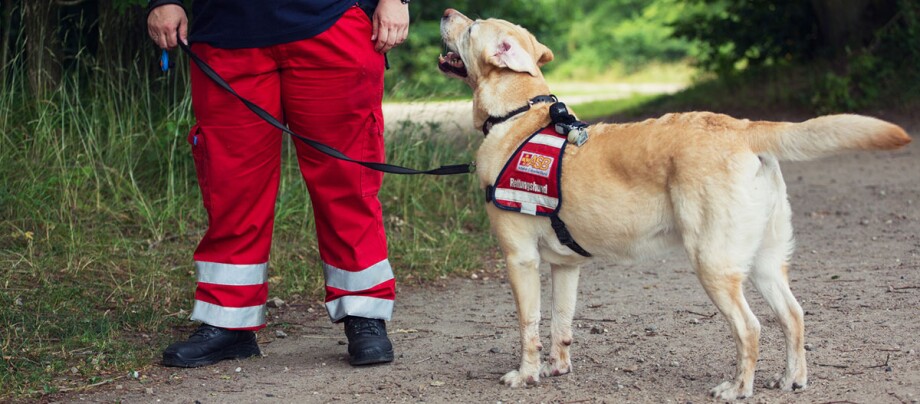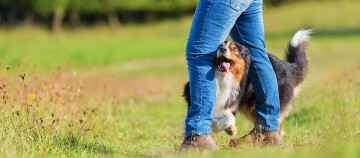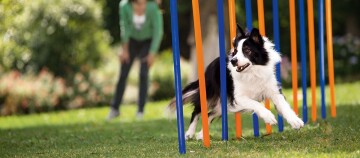Rescue Dogs – Suitable Breeds, Their Uses and Their Training
07.10.2022 - Reading time: 3 minutes

Rescue dogs are indispensable in many life-saving situations. They are tireless helpers in search and rescue operations for avalanche victims or missing people. Rescue dogs are often the only reliable way of finding those who are injured alive. Do you want to find out more about the exciting work of rescue dogs? Then keep reading!
History of the rescue dog: an ancient profession for good sniffers
The profession of today’s rescue dog goes back to a very ancient field of activity of the domestic dog. As far as we know, the first four-legged rescuers of humans date back to the 17th century and were the famous St. Bernards bred by the monks on the Great Saint Bernard mountain.
This robust, strong and good-natured breed originally helped the monks with many tasks as a working and herding dog. It happened repeatedly that people were buried in snow falls when crossing the Alps or slipped into rock crevices when visibility was poor. It is reported that it was the St. Bernards who led lost people to the hospice and thus saved their lives. However, the actual training of domestic dogs as rescue dogs did not begin until they were deployed in the First and Second World Wars.
The work of the modern rescue dog
Nowadays, rescue dogs are professionally trained to help people who have been injured or lost as efficiently as possible. In these missions, technical tracking devices prove to be insufficient. Dogs, on the other hand, with their potent nose with approx. 250 million olfactory receptors (compared to humans with only around 25 million) and the amazing ability to smell spatially, are made for this task. The modern rescue dog never works alone, but forms a closely coordinated, so-called rescue dog team together with his rescue dog handler. If necessary, rescue dog teams are deployed in several units, so-called rescue dog squads or a rescue dog platoon.
The rescue dog is guided by to the given scent of a specific person (mantrailing) or by general human scent traces from the air or on the ground. In many cases, the dog indicates its finding by barking or pawing. At a distance and in difficult terrain, running back and forth between the dog handler and the location of the find or the dog staying with the victim and barking at him are the best ways to indicate the find.
Areas of use for rescue dogs
Many rescue dogs are specialised in certain disasters and accident scenarios. Classic areas of use for search or rescue dogs are:
Outdoor searches
Avalanche search
Rubble search
Water rescue
Special operations: Water detection and corpse finding
Rescue dogs: breeds and characteristics of these four-legged heroes
In principle, almost any dog can be trained as a rescue dog, regardless of breed. It must be healthy, fit, powerful and basically interested in solving tasks.
Specific breeds of dogs have proven their worth depending on the field of deployment. These include in particular herding dogs such as German/Belgian Shepherds, Border Collies, Australian Shepherds, but also retriever breeds. They are particularly resilient, docile, task-oriented and persevering. Some special breeds such as Samyed or hunting dogs like Pointer or Beagle are also well qualified.
A rescue dog must have the following essential characteristics:
- Strength of character: The dog must be mentally balanced with a healthy self-confidence and absolute nerves of steel, and must not be aggressive or fearful
- Physiological characteristics: The rescue dog must be of at least medium height and light weight. Excessively small or large dogs are not suitable as rescue dogs. Stability and good handling of different ground situations are equally desirable.
- Age: Dogs between 6 and 12 months of age are ideal, the maximum age being 2 years.
How does a pet dog become a rescue dog?
Before a pet dog becomes a rescue dog, the dog and owner must pass several demanding tests. Perfectly coordinated obedience work is obligatory, which is completed with the companion dog test. This is followed by a varied basic training in the following fields of work:
Working fields of a rescue dog
- Field work: Exercises in difficult terrain (pipes, ladders, etc.)
- Field work: Exercises on difficult surfaces (smooth, moving, grids etc.)
- Alert work: Verbal alert language (barking, pointing back, pawing etc.)
- Search work: in area search and rubble search.


